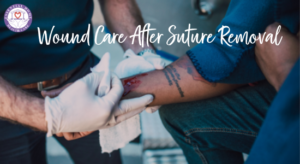Depending on the location of the wound, stitches are typically removed after 14 days. Your healthcare professional will inform you when to return for the removal of your stitches. Your provider will pluck up the knot of each stitch using sterile forceps or tweezers. He or she will use scissors to snip the stitch and then pull it out. You may experience a tiny tug as the stitch is extracted.

INSTRUCTIONS FOR DISCHARGE
Return to the emergency department if you experience any of the following:
- Your wound has split open or is beginning to unravel.
- You suddenly find yourself unable to move your afflicted joint.
You experience a sudden numbness in the area surrounding your wound. - You notice red streaks emanating from the wound.
Consult your healthcare professional if you experience any of the following:
- You’re experiencing a fever and chills.
- Your wound is red, hot, puffy, or pus-filled.
- Your wound emits an unpleasant odor.
- You are experiencing greater discomfort in the location of the wound.
- You have concerns or questions about your condition or treatment.
After the stitches are removed, the region should be cared for as follows:
Avoid removing the medical tape. After the sutures are removed, your physician may apply thin strips of medical tape to the wound. These pieces will naturally peel and fall off. Avoid yanking them off.
As directed, clean the area. Wash the area thoroughly with soap and water. With a clean cloth, pat the area dry. Examine the region for infection-related symptoms such as redness, swelling, or pus. Additionally, ensure that the wound is not breaking apart. Prevent your wounds from water and call for wound care orders for home health.
Take care of your wound. If your wound is stretched or bumped, it may expand, hemorrhage, or break open. Until your wound is entirely healed, you may need to wear a bandage that supports it.
Take care of a scar. After the stitches are removed, you may have a scar. Sunblock should be applied if the area is exposed to the sun. Apply it daily following the removal of the stitches. This will assist in the prevention of skin discoloration. Consult your healthcare practitioner about medications that can help conceal the scar. Certain medications are available without a physician’s prescription.
Should I Cover Wound After Stitches Removed
Skin closure tapes, alternatively referred to as adhesive strips, have gained popularity in recent years. There are numerous advantages to skin closure tapes. With sticky strips, the rate of wound infection is lower than with sutures. Additionally, skin closure tape application requires less time. When skin closure tapes are used, many patients do not require a painful anesthetic injection. The disadvantages of employing skin closure tapes over suturing include a lack of precision in bringing wound edges together. Not all body parts can be taped. For instance, parts of the body that produce secretions, such as the armpits, palms, or soles, are difficult to adhere adhesive strips to. Hairy areas would likewise be unsuitable for taping. How to do wound care after suture removal?
To close a wound, adhesive substances can be utilized. This material is applied to the wound’s margins in a manner similar to glue and should keep the wound’s edges together until healing occurs. Adhesive glue is the newest type of wound treatment and is quickly gaining popularity as a non-stitched alternative, particularly for youngsters. After around 5-7 days, the adhesive just peels off or wears away.
Vaseline After Stitches Removed
- Apply Vaseline or Aquaphor for a further 2-3 weeks after suture removal. AVOID antimicrobial ointment since it may create a rash or irritation.
- To achieve the optimum effects, the wound(s) should be disturbed as little as possible.
What Do You Apply To the Skin Once The Stitches Have Been Removed?
Daily, wash the wound with soap and water and pat it dries gently. Contamination-prone areas (such as hands) should be cleaned more often. For 5-7 days, cover regions prone to contamination or re-injury, such as the knees, elbows, hands, or chin. Typically, a simple Band-Aid will suffice.
Can Vaseline be Applied On Sutures Following Surgery?
For the first day, keep the wound wrapped and dry. After the first day, bathe the area around the wound twice daily with clean water. Avoid using hydrogen peroxide or alcohol, which might cause the wound to heal more slowly. You can use a thin coating of petroleum jelly, such as Vaseline, and a nonstick bandage to cover the wound.
Is There Anything I Need to Do After My Stitches Are Removed?
Following suture removal, wound care is equally as critical as it was prior to suture removal. Take thorough care of the wound to ensure that it heals without scarring. Continue to apply adhesive strips to the wound for approximately 5 days.
Is Vaseline Beneficial In the Healing of Surgical Wounds?
Along with keeping your wound clean, Vaseline forms a protective barrier around it and promotes healing by minimizing the impacts of infection. For many patients following facial reconstruction surgery in the US, ointments based on petroleum jelly, such as Vaseline, are the best choice of care.
What Do You Apply to a Wound Once The Stitches Have Been Removed?
Daily, wash the wound with soap and water and pat it dries gently. Contamination-prone areas (such as hands) should be cleaned more often. For 5-7 days, cover regions prone to contamination or re-injury, such as the knees, elbows, hands, or chin. Typically, a simple Band-Aid suffices.
As recommended, consult your healthcare provider:
If the stitches are on your face, you may need to return in 3 to 5 days. After 7 to 14 days, stitches on the scalp should be removed. Stitches placed over joints may be left in place for up to 14 days. Make a list of your questions so that you don’t forget to ask them throughout your visits.
You can do wound care after suture removal as well as you can perform wound dressing at home. You can also care for wounds with silver nitrate but for assistance, you should look for a wound dressing at home near me. For this contact Essential Home Health Care and Call us at (847) 813 6301.
